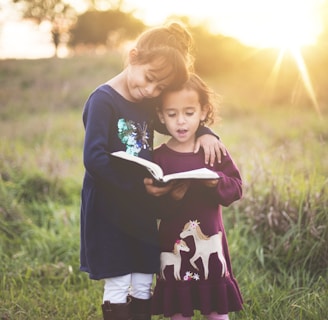Transform Your World with Language Learning at GlossArt Languages!
Raising Bilingual Kids: When to Start and How to Create a Supportive Language Environment
Explore the ideal age for children to start learning multiple languages and provide strategies for fostering a safe bilingual environment. Key methods such as the One Parent, One Language (OPOL) approach, balancing home and community languages, and ensuring consistent exposure through books, games, and media.Common mistakes parents make—such as inconsistency, over-correcting, and pressuring children—offering solutions to create a natural, engaging language-learning experience. The long-term benefits of bilingualism, including enhanced cognitive skills, cultural awareness, and broader career opportunities.
4/16/20242 min read


Raising Bilingual Kids: When and How to Start
Bilingualism is one of the greatest gifts parents can offer their children. The ability to speak more than one language not only enhances cognitive development but also fosters cultural awareness and communication skills. But when should children start learning a second language, and how can parents create a safe and nurturing bilingual environment?
When Should Kids Start Learning a Second Language?
Research suggests that the earlier a child is exposed to multiple languages, the better. Here are key stages of language learning:
Infancy (0-3 years): Babies are born with the ability to recognize and differentiate between different sounds. Exposure to multiple languages during this critical period helps them develop native-like pronunciation.
Preschool (3-5 years): Children at this age are highly receptive to new sounds and words, making it an ideal time to introduce a second language.
School Age (6+ years): While learning a second language is still possible, it may take longer for children to develop native-like fluency compared to those who started earlier.
Creating a Safe and Supportive Bilingual Environment
For parents from different linguistic backgrounds, raising bilingual kids requires consistency and an encouraging approach. Here are some strategies:
1. One Parent, One Language (OPOL)
Each parent consistently speaks a different language to the child. This helps avoid confusion and ensures balanced language exposure.
2. Home Language vs. Community Language
If one language is dominant in the community, parents can prioritize the minority language at home to ensure fluency in both.
3. Interactive Language Exposure
Read books in both languages.
Play bilingual games.
Watch cartoons or listen to songs in each language.
Encourage storytelling and conversations.
4. Create a Judgment-Free Zone
It’s common for bilingual children to mix languages (code-switching). Parents should avoid correcting every mistake and instead reinforce correct usage through repetition and exposure.
5. Seek Out Bilingual Education and Social Interaction
Enroll children in bilingual or language immersion schools.
Connect with other bilingual families.
Travel to places where both languages are spoken.
The Long-Term Benefits of Bilingualism
Studies show that bilingual children have enhanced problem-solving skills, better multitasking abilities, and stronger cognitive flexibility. They also develop a deeper appreciation for different cultures and improved career opportunities in the future.
Final Thoughts
Language learning is a journey, and the key to raising bilingual kids is patience, consistency, and a positive attitude. Whether through structured learning or natural immersion, giving children the gift of multiple languages opens doors to endless opportunities in life.
So, how will you introduce bilingualism to your child?
Written by Evangelia Perifanou


